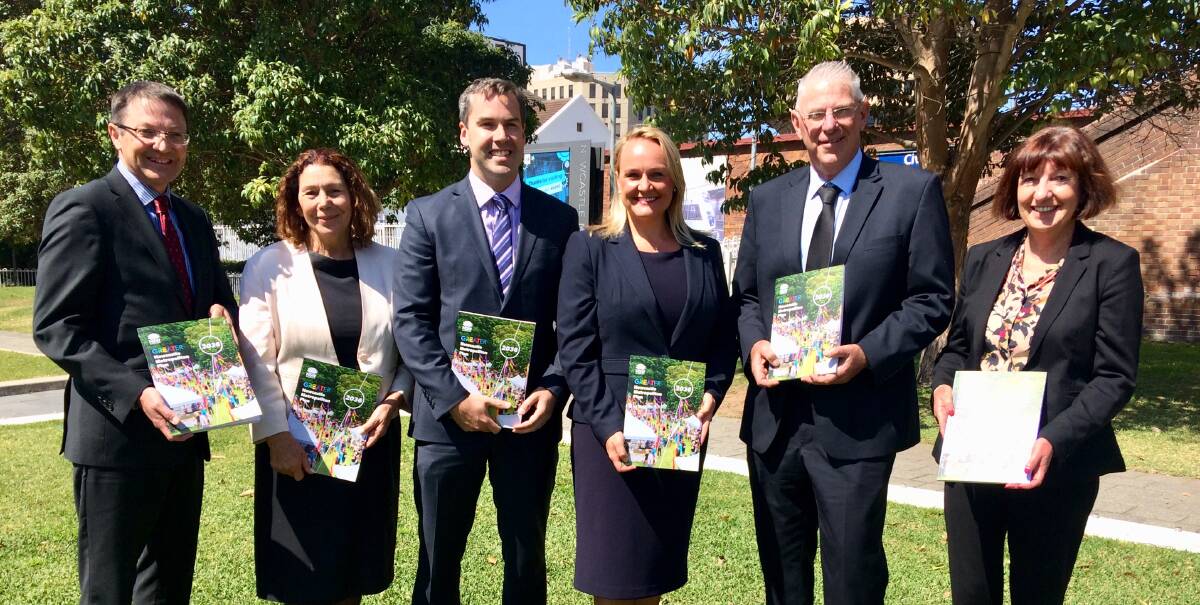
A collaborative approach to jobs, housing and transport is the focus of the Greater Newcastle Metropolitan Plan – the first metro plan in Australia to be completed outside a capital city.
Subscribe now for unlimited access.
or signup to continue reading
The document sets out aims up to 2036 for Greater Newcastle, which includes Newcastle, Lake Macquarie, Maitland, Port Stephens and Cessnock council area.
It puts forward four major outcomes – providing more skilled employment, enhancing amenity and the environment, delivering housing close to jobs and services and improving connections to work, services and recreation facilities. The plan was developed by the NSW government and the five Greater Newcastle councils.
NSW Planning Minister Anthony Roberts launched the plan with the five mayors on Monday, after the draft was released last November.
“The [plan] puts the strategy firmly in place to attract more businesses and skilled workers and to maximise the commercial business opportunities of the Port of Newcastle and Newcastle’s expanding airport, bringing greater exports and critical tourism capital,” he said.
The document identifies the need to improve public transport services between Newcastle CBD, John Hunter Hospital, Broadmeadow, Callaghan, Cardiff, Charlestown and Kotara.
It also pledges to make clear which state development contribution funds will be used to work towards the outcomes of the metro plan, through the Hunter Special Infrastructure Contribution.
Newcastle lord mayor Nuatali Nelmes said the plan was “so very important when you’re looking at laying down the future foundations of a city” and would deliver on-the-ground outcomes.
“This is looking at how you improve liveability in an emerging global city,” she said. “As Newcastle and surrounds grows, you actually need a coordinated approach to that growth.”
Greater Newcastle’s population will expand by 116,000 to 692,000 people by 2036, according to the plan, with an extra 60,450 dwellings predicted for the metro area.
It also forecasts an extra 21,200 jobs across the 11 catalyst areas – locations considered important for employment and residential growth – in the next two decades. The catalyst areas include North West Lake Macquarie, East Maitland, Black Hill/Beresfield, Tomago, Williamtown, Callaghan, John Hunter Hospital, Kotara, Broadmeadow and Newcastle CBD.
Newcastle city centre is expected to account for about one third of these, with 7750 new jobs predicted.
North West Lake Macquarie has been added as one of the catalyst areas since the draft, including economic centres Glendale and Cardiff.
Lake Macquarie mayor Kay Fraser said the inclusion was a “common sense acknowledgement” of the area’s importance.
“With the potential offered by the residential redevelopment of the former Pasminco site, the linking of Boolaroo and Cardiff through the Munibung Road extension and the planned expansion of Stockland Glendale and the Hunter Sports Centre, the area is set to boom,” she said.
“Council has also started a conversation around the future use of former mining land at Teralba, which could offer significant opportunities for manufacturing, light industrial and emerging industries in the digital economy.”
Mr Roberts also inspected one of the city’s new trams with Transport Minister Andrew Constance during his visit. However, Monday’s metro plan launch outside Civic Station was anything but smooth.
A group of protesters who had been picketing outside the University of Newcastle’s NeW Space building about conditions for uni staff approached and began yelling criticism about public transport, housing affordability and employment.

